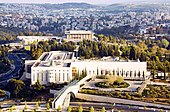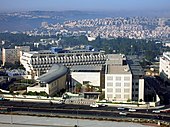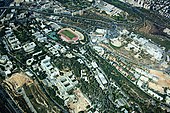Givat Ram: Difference between revisions
m →Archaeological findings: Unspacing |
Asparagusus (talk | contribs) m Reverted edits by 85.104.193.51 (talk) (AV) |
||
| (130 intermediate revisions by 82 users not shown) | |||
| Line 1: | Line 1: | ||
{{Short description|Neighborhood in Jerusalem, Israel}} |
|||
[[Image:Givat Ram campus.jpg|thumb|350px|Givat Ram campus of the Hebrew University]] |
|||
[[File:WikiAir_IL-13-06_021_-_Kiryat_HaMemshala.JPG|thumb|Aerial view of [[Kiryat HaMemshala]] on Givat Ram, with the [[Knesset]] in the lower right corner and the [[Supreme Court of Israel]] in the upper left corner]] |
|||
'''Givat Ram''' ({{lang-he-n|גִּבְעַת רָם}} is a neighborhood in central [[Jerusalem]], [[Israel]]. The [[Knesset]] and Israeli government offices are located in Givat Ram, as are the [[Israel Museum]], the [[Bible Lands Museum]], the [[Bloomfield Science Museum]], one of the campuses of the [[Hebrew University of Jerusalem]], the [[National Library of Israel]], the [[Israeli Supreme Court]] and the [[Binyanei HaUma]] convention center. |
|||
'''Givat Ram''' ({{lang-he|גִּבְעַת רָם}}) is a neighborhood in central [[Jerusalem]]. It is the site of [[Kiryat HaMemshala]] ([[Hebrew language|Hebrew]]: קריית הממשלה, ''lit.'' Government complex), which includes many of Israel's most important national institutions, among them the [[Knesset]] (Israel's Parliament), the [[Israel Museum]] (as well as the private [[Bible Lands Museum Jerusalem|Bible Lands Museum]]), the [[Israeli Supreme Court|Supreme Court]], [[Bank of Israel]], [[Academy of the Hebrew Language]], [[National Library of Israel|National Library]], one of the campuses of the [[Hebrew University of Jerusalem]], and many government ministries' offices. |
|||
==Etymology== |
==Etymology== |
||
Two versions: |
|||
''Ram'' is a Hebrew acronym for Rikuz Mifakdim - {{lang-he| גבעת ריכוז-מפקדים}}, lit. ''Officers assembly hill''<ref>Yad Ben Zvi website (Hebrew) [http://www.ybz.org.il/?ArticleID=1492]</ref><ref>Jerusalem Municipality website [http://www.jerusalem.muni.il/english/sys/tour/vir_tour/show/show_tour.asp?tour_id=115]</ref> Givat Ram also means "mighty hill." |
|||
# ''Ram'' is a Hebrew acronym for Rikuz Mefakdim – {{lang-he|ריכוז-מפקדים}}, lit. ''officers' assembly'', therefore Giv'at Ram means ''Officers' assembly hill''.<ref>{{cite web|url=http://www.ybz.org.il/?ArticleID=1492 |title=Yad Ben Zvi website (Hebrew) |publisher=Ybz.org.il |access-date=2013-01-20}}</ref><ref>{{cite web |url=http://www.jerusalem.muni.il/english/sys/tour/vir_tour/show/show_tour.asp?tour_id=115 |title=Jerusalem Municipality website |publisher=Jerusalem.muni.il |access-date=2013-01-20 |url-status=dead |archive-url=https://web.archive.org/web/20120222045055/http://www.jerusalem.muni.il/english/sys/tour/vir_tour/show/show_tour.asp?tour_id=115 |archive-date=2012-02-22 }}</ref> |
|||
# ''Ram'' is a Hebrew acronym for Rehavia Hamurhevet – {{lang-he|רחביה המורחבת}}, lit. expansion of [[Rehavia]], and there are maps and over evidence for the efforts to build this neighborhood in the 40's. <ref>{{Cite web |last=Hesse |first=Gilad |title=Facebook post |url=https://www.facebook.com/gilad.hesse/posts/pfbid0vWM2f |access-date=2023-04-26 |website=www.facebook.com |language=en}}</ref><ref>{{Cite web |title=אוניברסיטת בר-אילן |url=https://www.facebook.com/biu.info/posts/pfbid029TAY1Ze1uoxAgxkSqXACRkRFkAnFbyrx7LQurVaCjedVoVGHEVkEw5dFx87ETiQ1l |access-date=2023-04-26 |website=www.facebook.com |language=en}}</ref><ref>{{Citation |last=מלבסקי |first=עברית: אברהם |title=עברית: ירושלים - החוצב מכשיר את הקרקע להנחת היסודות לבתים הראשונים בשכונה החדשה של רחביה המורחבת, הנבנית על אדמת הקק"ל |date=1 March 1947 |url=https://commons.wikimedia.org/wiki/File:%D7%99%D7%A8%D7%95%D7%A9%D7%9C%D7%99%D7%9D_-_%D7%94%D7%97%D7%95%D7%A6%D7%91_%D7%9E%D7%9B%D7%A9%D7%99%D7%A8_%D7%90%D7%AA_%D7%94%D7%A7%D7%A8%D7%A7%D7%A2_%D7%9C%D7%94%D7%A0%D7%97%D7%AA_%D7%94%D7%99%D7%A1%D7%95%D7%93%D7%95%D7%AA_%D7%9C%D7%91%D7%AA%D7%99%D7%9D_%D7%94%D7%A8%D7%90%D7%A9%D7%95%D7%A0%D7%99%D7%9D_%D7%91%D7%A9%D7%9B%D7%95%D7%A0%D7%94_%D7%94%D7%97%D7%93%D7%A9%D7%94_%D7%A9%D7%9C_%D7%A8%D7%97%D7%91%D7%99%D7%94_%D7%94%D7%9E%D7%95%D7%A8%D7%97%D7%91%D7%AA,_%D7%94%D7%A0%D7%91%D7%A0%D7%99%D7%AA_%D7%A2%D7%9C-JNF040505.jpeg |access-date=2023-04-26}}</ref> |
|||
==History== |
==History== |
||
[[File:Givat ram entrance night 1.jpg|thumb|Edmond J. Safra Campus, [[Hebrew University of Jerusalem]]]] |
|||
Before Israel's [[Israeli War of Independence|War of Independence]] in 1948, the area was known by the Arabs as [[Sheikh Badr]]. In December 1949, the Israeli government headed by [[David Ben-Gurion]], passed a resolution to build a government precinct in Jerusalem. Givat Ram, a hill in the west of the city, which had been an assembly point for the [[Gadna (Israel)|Gadna Youth Battalions]], was chosen for this purpose. The topography of the site, made up of three ridges, meshed with the idea of establishing three clusters of buildings - the government precinct, a university campus and a museum.<ref>http://www.google.com/search?q=givat+ram&hl=en&sourceid=gd&rls=GGLD,GGLD:2006-01,GGLD:en</ref> |
|||
Before 1948, maps of the area drawn by the [[Survey of Palestine]] team tagged it as Karam es Sila. The name indicates it was a ''karam'' (grape field) belonging to the Sala (שלה might be originally סלע or سلع) family or the grape field near stone quarries. |
|||
Before the [[1947–1949 Palestine war|1947–1949 Arab-Israeli war]], the area in the north was known by the Arabs as [[Sheikh Badr]]. In December 1949, the Israeli government, headed by [[David Ben-Gurion]], passed a resolution to build a government precinct in Jerusalem. Givat Ram, a hill in the west of the city, which had been an assembly point for the [[Gadna (Israel)|Gadna Youth Battalions]], was chosen for this purpose. The topography of the site was made up of three ridges, meshed with the idea of establishing three clusters of buildings – the government precinct, a university campus and a museum. {{Citation needed|reason=Previous source was a Google Search for the article's title|date=November 2021}}[[File:Jerusalem-Compiled,_drawn_and_printed_by_the_Survey_of_Palestine-1.jpg|thumb|Jerusalem, Produced by the [[Survey of Palestine]], 1945-1946]]The Knesset, Israeli government offices, and the Israeli Supreme Court are located in Givat Ram, as are cultural landmarks such as the Israel Museum, the Bible Lands Museum,<ref>{{cite web|url=http://www.israelnationalnews.com/News/News.aspx/135838 |title=Jewish Pride: Prime Minister's Son Wins Bible Contest |publisher=Israelnationalnews.com |access-date=2013-01-20}}</ref> the [[Bloomfield Science Museum]], a campus of the Hebrew University of Jerusalem,<ref>{{cite book|url=https://books.google.com/books?id=6x3S8eM3spAC&q=attacks+on+medical+convoys+to+mount+scopus&pg=PA193 |title=International dictionary of university histories: edited by Carol Summerfield and Mary Elizabeth Devine |isbn=9781884964237 |access-date=2013-01-20|last1=Summerfield |first1=Carol J. |last2=Devine |first2=Mary Elizabeth |last3=Levi |first3=Anthony |year=1998 }}</ref> the [[National Library of Israel]],<ref name=Haaretz>{{cite news |author = Aryeh Dayan |author-link = Aryeh Dayan |title = New chapter in a sad saga |publisher = [[Haaretz]] |url = http://www.haaretz.com/hasen/spages/919549.html |access-date=October 1, 2008 }}</ref> and [[Binyanei HaUma]] - The National Convention Center. |
|||
The northern part of the neighborhood, between the convention center and the university, where the government ministries are clustered, is officially known as [[Kiryat HaLeom]]. A new apartment project, Mishkenot Ha’uma, is being built in this area.<ref>{{cite web |url=http://www.jpost.com/LocalIsrael/InJerusalem/Article.aspx?id=192283 |title= A luxury we can't afford |author=Paul Widen |publisher=The Jerusalem Post |location=Jerusalem |date=October 22, 2010 |access-date=2011-06-13}}</ref> The [[Wohl Rose Garden]] is also located in the neighborhood. |
|||
==High-Tech village== |
|||
The Givat Ram High-Tech Village was established jointly by the [[Jerusalem Development Authority]] and the Hebrew University. It is one of the first high tech parks in Israel built in proximity to centers of academic research. It provides a starting base for technological start-up companies.<ref>{{cite web|url=http://www.jda.gov.il/template/default_e.aspx?Cid=28|title=JDA - Development Of Employment And Industrial Parks|website=www.jda.gov.il|access-date=22 April 2018|archive-date=23 April 2018|archive-url=https://web.archive.org/web/20180423101850/http://www.jda.gov.il/template/default_e.aspx?Cid=28|url-status=dead}}</ref> |
|||
==Archaeological findings== |
==Archaeological findings== |
||
The first salvage excavation was conducted before [[Binyanei HaUma]] was built, in July- August 1949, by M. Avi-Yonah, who unearthed hewn installations, cisterns and pools of various sizes dating to the Herodian period, bricks and tiles bearing stamps of the [[ |
The first salvage excavation was conducted before [[Binyanei HaUma]] was built, in July- August 1949, by [[M. Avi-Yonah]], who unearthed hewn installations, cisterns and pools of various sizes dating to the Herodian period, bricks and tiles bearing stamps of the [[Legio X Fretensis|Tenth Roman Legion]], and the remains of a monastery. |
||
[[File:Israeli_Air_Force_Fly_By._Israel_73rd_Independence_Day,_April_2021._XIV.jpg|thumb|View of the [[Knesset]], on Givat Ram. [[Rehavia]] is on the background]] |
|||
In May–June 1968, before a new hotel (then the Hilton) was built south of Binyanei HaUma, Avi-Yonah conducted a second salvage excavation. He found remains of an oval-shaped potter's kiln, a preparation area for clay, and a deep water cistern. The area had been covered by a thick layer of plaster upon which were found large [[mortaria]] and many bricks, some bearing stamps of the Tenth Legion. |
|||
During the work on a new international convention center east of Binyanei HaUma, a large salvage excavation was conducted in April–September 1992 on behalf of the [[Israel Antiquities Authority]], but roughly 60% of the parking lot area had already been dug up by bulldozers. |
|||
| ⚫ | In July 1993, a small excavation in the northwestern corner dismantled kilns of the Tenth Legion and lifted a [[mosaic]] floor of the [[Byzantine]] period.<ref>{{cite web|url=http://www.fas.harvard.edu/~semitic/wl/publications/binyaneihauma.html|archive-url=https://archive.today/20120623024934/http://www.fas.harvard.edu/~semitic/wl/publications/binyaneihauma.html|url-status=dead|title=Binyanei Ha'Uma - The Shelby White - Leon Levy Program for Archaeolog…|date=23 June 2012|archive-date=23 June 2012|website=archive.is|access-date=22 April 2018}}</ref> |
||
During the work on a new international convention center east of Binyanei HaUma, a large salvage excavation was conducted in April-September 1992 on behalf of the [[Israel Antiquities Authority]], but roughly 60% of the parking lot area had already been dug up by bulldozers. |
|||
== Photo gallery == |
|||
| ⚫ | In July 1993, a small excavation in the northwestern corner dismantled kilns of the Tenth Legion and lifted a [[mosaic]] floor of the [[Byzantine]] period.<ref> |
||
<gallery widths="170" heights="170"> |
|||
File:Israel museum.JPG|Aerial photograph of the [[Israel Museum]], with the [[Knesset]] in the background |
|||
File:Israel Supreme Court.jpg|[[Supreme Court of Israel]], with the [[Knesset]] on the background |
|||
File:Hutz.JPG|[[Ministry of Foreign Affairs (Israel)|Ministry of Foreign Affairs]], with the [[Bank of Israel]] in the background |
|||
File:The knesset illuminated.jpg|Knesset at Dusk |
|||
File:WikiAir IL-13-06 020 - Givat Ram.JPG|Aerial view of Givat Ram |
|||
</gallery> |
|||
==See also== |
|||
*[[Kiryat HaMemshala]] |
|||
*[[Sheikh Badr Cemetery|Sheikh Bader cemetery]] or Givat Ram cemetery, Jewish Israeli cemetery used between 1948–1951 |
|||
==References== |
==References== |
||
{{Commons category|Giv'at Ram}} |
|||
{{reflist}} |
|||
{{Reflist}} |
|||
<imagemap> |
|||
File:WikiAir_IL-13-06_020_-_Givat_Ram.JPG|thumb|500px|center|Aerial view of Givat Ram, August 2013. This image has annotations. Move the mouse pointer over the image to see them. |
|||
circle 1599 816 269 [[Hebrew University Stadium]] |
|||
poly 1837 1584 1818 1808 2046 1900 2046 1686 1910 1575 [[Academy of the Hebrew Language]] |
|||
poly 19 1113 539 1541 49 1832 10 1842 5 1113 [[Jerusalem Academy of Music and Dance]] |
|||
poly 2362 39 2887 258 2673 481 1988 233 [[Knesset]] |
|||
rect 3713 622 3873 797 [[Monastery of the Cross]] |
|||
poly 3499 248 3003 165 2668 588 3849 1128 3883 467 [[Valley of the Cross]] |
|||
poly 505 1055 603 1205 899 1094 758 923 [[National Library of Israel]] |
|||
poly 2163 0 2143 87 1949 194 1788 194 1580 185 1468 122 1317 34 1273 0 [[Wohl Rose Park]] |
|||
circle 2746 880 39 [[Shrine of the Book]] |
|||
poly 2610 885 2795 1016 2717 1064 2595 1021 2537 967 2542 889 [[Holyland Model of Jerusalem]] |
|||
poly 2158 637 2168 758 2406 778 2406 666 [[Bible Lands Museum]] |
|||
poly 1628 262 1633 374 1754 360 1944 292 1915 204 [[Ministry of Finance (Israel)|Ministry of Finance]] |
|||
poly 1492 151 1507 238 1230 311 1215 209 [[Ministry of Interior (Israel)|Ministry of Interior]] |
|||
poly 1108 19 870 83 821 5 1074 0 [[Bank of Israel]] |
|||
poly 384 185 326 447 29 544 194 194 [[Hebrew University Secondary School]] |
|||
poly 413 272 394 413 622 374 642 253 [[American Jewish Joint Distribution Committee]] |
|||
poly 1147 335 1094 433 1361 501 1429 374 [[Bloomfield Science Museum]] |
|||
poly 2085 1152 3703 2561 3208 2561 2556 1818 2479 1808 1978 1142 [[Jerusalem Botanical Gardens]] |
|||
poly 258 1025 292 1098 462 1021 433 943 [[The Racah Institute of Physics]] |
|||
poly 544 10 471 156 792 228 1745 394 2245 433 2537 510 2692 530 2867 530 3018 505 3149 471 3135 394 2338 0 [[Kiryat HaMemshala]] |
|||
poly 24 583 724 389 1895 729 2036 1108 3708 2566 539 2561 [[Hebrew University of Jerusalem]] |
|||
poly 2814 651 3742 1152 3728 1380 3358 1502 2702 1191 2483 1006 2454 695 2644 646 2663 612 [[Israel Museum]] |
|||
desc bottom-left |
|||
</imagemap> |
|||
{{Neighborhoods of Jerusalem}} |
{{Neighborhoods of Jerusalem}} |
||
{{ |
{{Coord|31.78|N|35.20|E|scale:20000|display=title}} |
||
[[Category:Neighbourhoods of Jerusalem]] |
[[Category:Neighbourhoods of Jerusalem]] |
||
[[ar:تلة الشيخ بدر]] |
|||
[[is:Givat Ram]] |
|||
[[he:גבעת רם]] |
|||
[[mk:Гиват Рам]] |
|||
[[yi:גבעת רם]] |
|||
Latest revision as of 18:52, 24 April 2024

Givat Ram (Hebrew: גִּבְעַת רָם) is a neighborhood in central Jerusalem. It is the site of Kiryat HaMemshala (Hebrew: קריית הממשלה, lit. Government complex), which includes many of Israel's most important national institutions, among them the Knesset (Israel's Parliament), the Israel Museum (as well as the private Bible Lands Museum), the Supreme Court, Bank of Israel, Academy of the Hebrew Language, National Library, one of the campuses of the Hebrew University of Jerusalem, and many government ministries' offices.
Etymology[edit]
Two versions:
- Ram is a Hebrew acronym for Rikuz Mefakdim – Hebrew: ריכוז-מפקדים, lit. officers' assembly, therefore Giv'at Ram means Officers' assembly hill.[1][2]
- Ram is a Hebrew acronym for Rehavia Hamurhevet – Hebrew: רחביה המורחבת, lit. expansion of Rehavia, and there are maps and over evidence for the efforts to build this neighborhood in the 40's. [3][4][5]
History[edit]

Before 1948, maps of the area drawn by the Survey of Palestine team tagged it as Karam es Sila. The name indicates it was a karam (grape field) belonging to the Sala (שלה might be originally סלע or سلع) family or the grape field near stone quarries.
Before the 1947–1949 Arab-Israeli war, the area in the north was known by the Arabs as Sheikh Badr. In December 1949, the Israeli government, headed by David Ben-Gurion, passed a resolution to build a government precinct in Jerusalem. Givat Ram, a hill in the west of the city, which had been an assembly point for the Gadna Youth Battalions, was chosen for this purpose. The topography of the site was made up of three ridges, meshed with the idea of establishing three clusters of buildings – the government precinct, a university campus and a museum. [citation needed]

The Knesset, Israeli government offices, and the Israeli Supreme Court are located in Givat Ram, as are cultural landmarks such as the Israel Museum, the Bible Lands Museum,[6] the Bloomfield Science Museum, a campus of the Hebrew University of Jerusalem,[7] the National Library of Israel,[8] and Binyanei HaUma - The National Convention Center.
The northern part of the neighborhood, between the convention center and the university, where the government ministries are clustered, is officially known as Kiryat HaLeom. A new apartment project, Mishkenot Ha’uma, is being built in this area.[9] The Wohl Rose Garden is also located in the neighborhood.
High-Tech village[edit]
The Givat Ram High-Tech Village was established jointly by the Jerusalem Development Authority and the Hebrew University. It is one of the first high tech parks in Israel built in proximity to centers of academic research. It provides a starting base for technological start-up companies.[10]
Archaeological findings[edit]
The first salvage excavation was conducted before Binyanei HaUma was built, in July- August 1949, by M. Avi-Yonah, who unearthed hewn installations, cisterns and pools of various sizes dating to the Herodian period, bricks and tiles bearing stamps of the Tenth Roman Legion, and the remains of a monastery.

In May–June 1968, before a new hotel (then the Hilton) was built south of Binyanei HaUma, Avi-Yonah conducted a second salvage excavation. He found remains of an oval-shaped potter's kiln, a preparation area for clay, and a deep water cistern. The area had been covered by a thick layer of plaster upon which were found large mortaria and many bricks, some bearing stamps of the Tenth Legion.
During the work on a new international convention center east of Binyanei HaUma, a large salvage excavation was conducted in April–September 1992 on behalf of the Israel Antiquities Authority, but roughly 60% of the parking lot area had already been dug up by bulldozers.
In July 1993, a small excavation in the northwestern corner dismantled kilns of the Tenth Legion and lifted a mosaic floor of the Byzantine period.[11]
Photo gallery[edit]
-
Aerial photograph of the Israel Museum, with the Knesset in the background
-
Supreme Court of Israel, with the Knesset on the background
-
Ministry of Foreign Affairs, with the Bank of Israel in the background
-
Knesset at Dusk
-
Aerial view of Givat Ram
See also[edit]
- Kiryat HaMemshala
- Sheikh Bader cemetery or Givat Ram cemetery, Jewish Israeli cemetery used between 1948–1951
References[edit]
- ^ "Yad Ben Zvi website (Hebrew)". Ybz.org.il. Retrieved 2013-01-20.
- ^ "Jerusalem Municipality website". Jerusalem.muni.il. Archived from the original on 2012-02-22. Retrieved 2013-01-20.
- ^ Hesse, Gilad. "Facebook post". www.facebook.com. Retrieved 2023-04-26.
- ^ "אוניברסיטת בר-אילן". www.facebook.com. Retrieved 2023-04-26.
- ^ מלבסקי, עברית: אברהם (1 March 1947), עברית: ירושלים - החוצב מכשיר את הקרקע להנחת היסודות לבתים הראשונים בשכונה החדשה של רחביה המורחבת, הנבנית על אדמת הקק"ל, retrieved 2023-04-26
- ^ "Jewish Pride: Prime Minister's Son Wins Bible Contest". Israelnationalnews.com. Retrieved 2013-01-20.
- ^ Summerfield, Carol J.; Devine, Mary Elizabeth; Levi, Anthony (1998). International dictionary of university histories: edited by Carol Summerfield and Mary Elizabeth Devine. ISBN 9781884964237. Retrieved 2013-01-20.
- ^ Aryeh Dayan. "New chapter in a sad saga". Haaretz. Retrieved October 1, 2008.
- ^ Paul Widen (October 22, 2010). "A luxury we can't afford". Jerusalem: The Jerusalem Post. Retrieved 2011-06-13.
- ^ "JDA - Development Of Employment And Industrial Parks". www.jda.gov.il. Archived from the original on 23 April 2018. Retrieved 22 April 2018.
- ^ "Binyanei Ha'Uma - The Shelby White - Leon Levy Program for Archaeolog…". archive.is. 23 June 2012. Archived from the original on 23 June 2012. Retrieved 22 April 2018.






